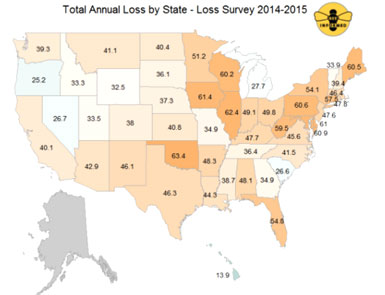Just in time for another year of devastating honey bee losses, the White House released its national pollinator strategy to restore populations of bees, butterflies and other pollinators.
Over the past year, 42% of honey bee colonies died according to the annual beekeeper survey conducted by Bee Informed Partnership, Apiary Inspectors of America and the US Department of Agriculture. That’s up from 34.2% the previous year.
These losses mean honey bee populations are losing ground. They are average losses – in some states beekeepers lost over 60% of bee colonies.

Credit: Bee Informed
Obama Administration Plan
Last year, President Obama issued an Executive Order to "reverse pollinator losses and help restore populations to healthy levels" of bees, birds, bats, and butterflies – as "critical contributors to our nation’s economy, food system, and environmental health."
He directed the Secretary of Agriculture (USDA) and EPA Administrator to co-chair a Pollinator Health Task Force that would develop a strategy for research and recovery of pollinator populations. He also directed federal agencies to substantially expand pollinator habitat on federal lands.
Today, they released the National Pollinator Health Strategy, which has these goals:
- Reduce honey bee colony losses during winter (overwintering mortality) to no more than 15% within 10 years (it was 23% in 2014).
-
Increase monarch butterflies to 225 million butterflies occupying 15 acres in their Mexico wintering grounds by 2020 – the average amount from 1994-2014.
-
Restore 7 million acres of land for pollinator habitat over the next 5 years through the Pollinator Partnership.
-
Asks Congress to appropriate $82.5 million to carry out this plan, $35 million more than the current budget.
The Strategy document says it is a "comprehensive approach to tackling and reducing the impact of multiple stressors on pollinator health, including pests and pathogens, reduced habitat, lack of nutritional resources, and exposure to pesticides." But most of that is part of the Pollinator Research Action Plan.
In terms of action, other than restoring habitat, most of it seems to be public/private partnerships that educate the public, farmers and beekeepers.
US Bee Buffer Project
The Pollinator Partnership’s goal is to restore honey bee habitat throughout the country – 6000 acres over the next year.
They began enrolling farms across California and North Carolina to plant bee buffers in late 2014 and received an overwhelming number of applications from both states and almost every state wants in, says Burts Bees, which is participating through its Greater Good Foundation.
So far, seeds have been planted in 200 bee buffers in all kinds of agricultural settings: ranches, vegetable farms, orchards, tree farms, apiaries, and others. They are experimenting with wildflower mixes to be able to make science-based planting decisions going forward.
Neonic Pesticides
Where’s the action on neonic pesticides that have been proven to be a major cause of pollinator population crash?
The EPA is being sued for failing to take action – it is allowing unabated use of neonics while it "reviews" the situation. Ontario beekeepers are taking the manufacturers to court.
Unbelievably, over the past year, EPA approved two new neonics, expanded their use to more crops, as well as the amounts that can be applied to crops. Then it announced there would be no new uses until its review is completed, which could take as long as two more years.
USDA researchers published an article in the April edition of Science of Nature making the connection between neonics and the decline of monarch butterflies. They showed impacts on caterpillars at doses as low as 1 part per billion (ppb) with lethal concentrations at 15 ppb in the lab. On the average South Dakoka corn farm, pollinators are exposed to higher levels than 1 ppb and for longer periods, and have to deal with multiple pesticides that scientists didn’t test for in the lab.
4 million Americans have signed petitions to ban neonics.
In the face of this inaction, Portland and Eugene, Oregon banned their use, and hopefully others will follow.
Friends of the Earth puts forth this strategy to save pollinators -calling for the strong action that’s necessary to reverse these losses:
- Cancel registrations of all systemic, persistent pesticides, including neonicotinoids, for all uses that pose risks to pollinators, beginning with unnecessary ones such as treating seeds and aesthetic purposes, and uses for which alternatives exist.
- Close the EPA "conditional registration" loophole which allows pesticides to enter the market before adequate toxicity testing is completed.
- Expedite development and implementation of valid test guidelines for sub-lethal effects of pesticides on pollinators and require data from these studies for all currently registered and new pesticides.
- Regulate planting treated seeds as a pesticide application.
- Ensure EPA compliance with the Endangered Species Act to prevent killing our nation’s most imperiled species.
- Require agencies to ensure that all federal lands and any new pollinator habitats are free of systemic insecticides and that all pollinator friendly flowers sold have not been pre-treated with these insecticides.
- Increase research on green alternatives pesticides.
Pollinators play a critical role in our food systems – one of every three bites we take – and just as crucially, they maintain diverse ecosystems, with 75% of all native plants requiring pollination.
Tell President Obama and the White House Task Force to take action on neonics right now. We don’t need more research:
